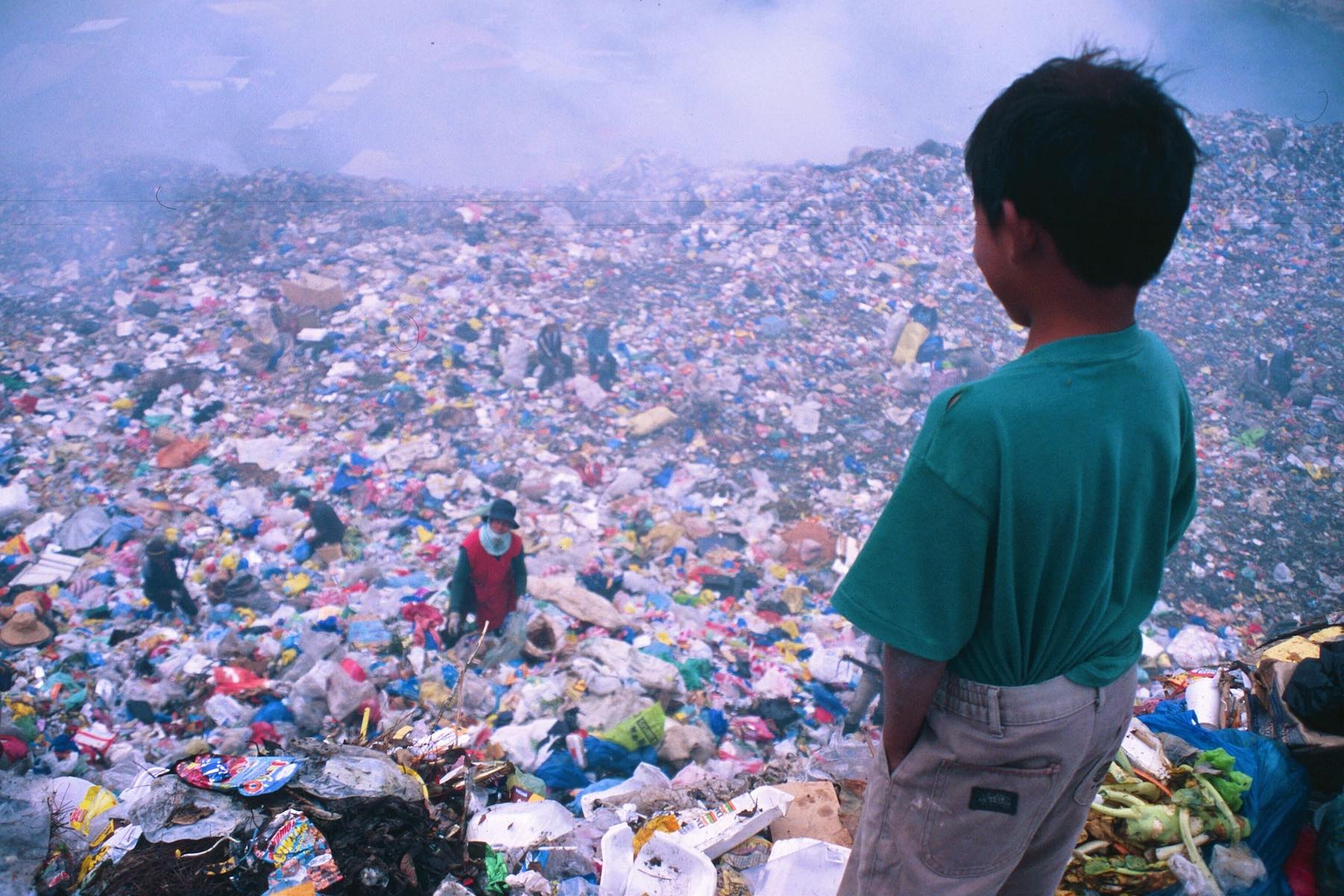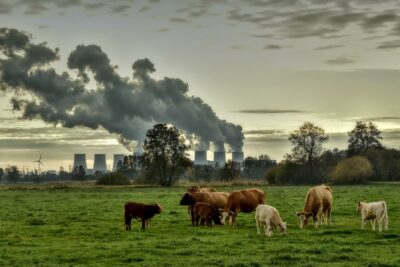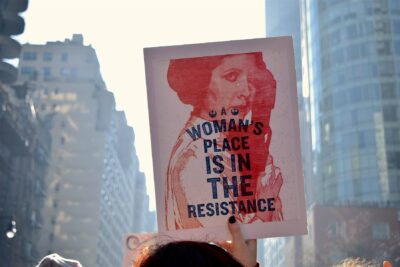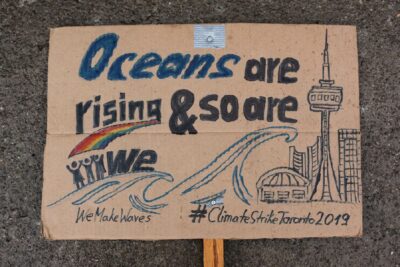We may take the air we breathe for granted but it is under threat by industrial processes, including animal agriculture, that cause air pollution. This can have a powerfully negative impact on our health, the environment, the climate, wild places, and all other species but there are things we can do to protect the clean air we need.
What Is Air Pollution?
Air pollution is the contamination of the indoor or outdoor environment by any chemical, physical, or biological agent that alters the natural characteristics of the atmosphere.
What Causes Air Pollution?
Some air pollution is from natural causes but most is caused by humans, and it can impact every aspect of our lives.
1. The Burning of Fossil Fuels
When fossil fuels are burned, they release large amounts of carbon dioxide into the air. This is a climate-altering gas. When we use dirty fuels — coal, gasoline, diesel — to power our cars, heat our homes, and drive industry, we are creating an environmental and existential catastrophe. A recent study found that not only does it destroy our climate, the burning of fossil fuels is responsible for the deaths of around eight million people a year.
2. Agricultural Activities
Farming animals, including fish, creates vast amounts of air pollution. Not only does producing animal products require a lot more land, which means the destruction of climate-protecting trees, but it creates a lot of dangerous emissions. More than 168 gases are emitted from factory farm waste, including hazardous chemicals such as ammonia, hydrogen sulfide, and methane. The animals trapped inside these farming systems suffer as a result, and so do the people who live nearby. Headaches, nausea, and other problems caused by the fumes and odors coming from such farms are commonplace, and children who live nearby suffer a higher incidence of asthma. Farm workers who inhale the toxic gases created by the animals’ waste may even die.
3. Waste in Landfills
Similar toxic gases are emitted from landfill sites. Ammonia, hydrogen sulfide, methane and carbon dioxide are all created when bacteria break down the trash we dispose of. The unpleasant odors are one thing, but these gases have health and environmental implications too. Not only do they contribute to the climate crisis, but even short-term exposure can lead to respiratory problems, irritation of the eyes, nose and throat, headaches, and nausea. When we throw things away, we contribute to this pollution, and it’s a reminder that nothing is entirely disposable; there are always consequences.
4. Exhaust From Factories and Industries
Since the dawn of industrialization, industries have been polluting the air with toxic chemicals and driving health and ecological crises. Often, they are powered by fossil fuels, which exacerbates their detrimental impact.
5. Mining Operations
Pollution is caused at every stage of the mining process, from excavation to transportation to processing to refining. At the start of the process, wind erosion and traffic cause unrefined materials from the site to become airborne. These may contain lead, arsenic, cadmium, and other toxic elements. Such pollutants are associated with diseases of the respiratory system and allergies.
6. Fishing Fleets
When we think of the impact our diets have on the environment, we tend to think of factory farming. But the fishing industry creates a lot of air pollution, too. One study found that fishing boats that trawl the ocean floor release as much carbon dioxide as the entire aviation industry.
7. Forest Fires
The size and frequency of wildfires are growing due to climate change. They release large quantities of carbon dioxide, carbon monoxide, and fine particulate matter into the atmosphere, which further drives climate breakdown and the likelihood of more forest fires. The resulting air pollution can cause both respiratory and cardiovascular problems. It is astonishing, therefore, that meat industry operations deliberately set fires to clear the way for the expansion of their operations.

What Are the Main Air Pollutants?
Fine Particulates
Fine particulate matter consists of tiny airborne particles that are released into the air from industrial, agricultural, domestic, and natural sources. Wildfires and volcanic eruptions can spread fine particle concentrations hundreds of miles from where they began. Factory farms are a real problem with dried waste, bedding, and feathers all contributing to this air pollutant. In the short term, exposure can lead to lung irritation, shortness of breath, and irritation of the eyes, nose and throat. Over the longer term, asthma and heart disease can develop.
Carbon Monoxide
Carbon monoxide is a colorless, odorless gas that can be harmful, even fatal, when inhaled. This gas is released when something is burned incompletely but most combustion processes produce some carbon monoxide. Road transportation and industry are major sources. Home heaters, generators, and barbecues can be risky, and cigarettes are another dangerous source. Short term exposure to small amounts can cause dizziness, muscle pain, and headaches. Long term exposure or exposure to a significant amount may cause weakness, confusion, heart and lung problems, loss of consciousness, and death.
Methane
Animal farming is the leading cause of methane pollution. Emissions from animals’ waste and the digestive tracts of cows, sheep, and goats account for around 32 percent of human-caused methane emissions. Methane is the primary contributor to the formation of ground-level ozone, which is a hazardous air pollutant, and it is also a powerful greenhouse gas. The combined methane emissions of 15 of the world’s largest meat and dairy companies are higher than those of Russia, Canada and Australia, according to one recent study. For the sake of a habitable planet, we need to change what we eat.
Ozone
Ozone is a gas which occurs both in the atmosphere and at ground level. Up in the atmosphere it forms a protective layer that shields us from harmful ultraviolet rays from the sun. At ground level, however, ozone is harmful to people and the planet. Ground level ozone is created by chemical reactions from other pollutants. Globally, ozone is responsible for hundreds of thousands of premature deaths and tens of millions of asthma-related emergency hospital visits each year.
Ammonia
The vast majority of ammonia pollution comes from animal farming — from the animals’ waste and the fertilizers made from that waste — and it can be incredibly harmful for sensitive habitats. In England, for example, more than 85 percent of the country’s total land area receives ammonia concentrations above the critical level set to protect lichens, mosses, liverworts, and similar plants. These are keystone species that are vital to ecosystems. Ammonia can cause damage to waterways, too, and harm aquatic life, while it can cause eye damage and even death to people.
Nitrogen Dioxide
This pollutant is caused predominantly by the emissions of vehicles and power plants. It can react in the air with other chemicals and create both ozone and particulate matter. When inhaled at high concentrations, nitrogen dioxide can irritate our respiratory systems, aggravating asthma and other conditions. Longer exposure may lead to nasty respiratory infections.
Lead
Lead is a heavy metal that can cause air pollution. Historically, lead pollution came from the emissions of vehicles and industrial sources but with the phase-out of leaded petrol in many parts of the world, lead pollution has declined. However, despite the ban, lead from petrol still persists in the atmosphere, and the manufacture of vehicle parts still contributes to lead pollution, as does the production of iron, steel, and cement. Once inhaled (or ingested) lead distributes throughout the body and accumulates in the bones. It can affect the nervous system, the immune system, reproductive and developmental systems, kidney function, and the cardiovascular system.
Sulfur Dioxide
Sulfur dioxide is an acidic gas which predominantly comes from the burning of coal and crude oil. Most of it comes from power plants and industrial processing. Vehicles like ships that burn high-sulfur fuel also emit this dangerous pollutant. It can cause irritation of the respiratory system, and can lead to asthma and chronic bronchitis. It is ecologically damaging, as it combines with water vapor in the atmosphere and forms acid rain, which damages forests and freshwater habitats.

What Are the Effects of Air Pollution?
Greenhouse Gases
One of the most devastating consequences of air pollution is climate breakdown. When we burn fossil fuels or farm animals for their meat, milk, and eggs, we release vast amounts of climate-altering gases. The only way to protect the planet is to change our behavior.
Smog and Soot
Smog is another word for ground level ozone, and it is caused when burning fossil fuels react with sunlight. Soot is particulate matter carried in the air. Both cause respiratory ill-health.
Mold
Mold is an indoor pollutant. Mold spores proliferate in damp environments so poorly heated or badly ventilated homes can be at risk. Mold is not only unpleasant, it can cause serious illness, even death. A two-year-old boy in Britain recently died from inhaling mold spores from the substandard social housing he lived in.
Acid Rain
Burning fossil fuels releases sulfur dioxide and nitrogen oxides which combine with oxygen and water in the atmosphere to fall as acid rain. This devastates forests, crops, waterways, and the life within them. Air pollution regulations have reduced acid rain in many parts of the world, but sadly not all.
Eutrophication
The damaging accumulation of nutrients in water often starts with air pollution. When nitrogen and sulfur from industry, including industrial animal farming, are released, they pollute their air and find their way into waterways. Once there, they trigger the explosive growth of algae, which uses up all the oxygen in the water. Animals who live there must flee or die.
Effect on Wildlife
Air pollution can seriously damage the ecosystems in which wild animals live. It can kill vegetation and insects, which has a knock-on impact on all other life. It can also affect wild animals directly, disrupting their endocrine function, causing organ damage, disease, and death. This is just one way that farming animals causes harm to wild animals.
Diseases
Air pollution can cause many diseases in people, including stroke, chronic obstructive pulmonary disease, various cancers, asthma, and lower respiratory infections. There is also evidence of a link between air pollution and type 2 diabetes, systemic inflammation, Alzheimer’s disease, and dementia.

What Are Air Pollution Solutions?
Most air pollution is human-generated, and that means we need to change our behavior in order to ensure we have clean air that is good for us and the world around us. Industries that make billions of dollars from polluting won’t change but if we boycott those industries and choose positive alternatives, we can create a safer, healthier world, despite them.
End Animal Agriculture
Animal farming drives climate breakdown, air and water pollution, deforestation, species loss, extinctions, and human health crises. It’s clear this is a pitless and reckless industry, and we do not need to fund it! We can withdraw our support from it by buying and eating plant-based foods instead. If you would like to know more, check out our 7-Day Vegan Challenges to give you a taste of what eating a vegan diet involves.
End Sea Fishing
The industrial fishing industry emits more climate-damaging emissions than the entire aviation sector. We do not need to eat fish for our health, and we certainly do not need the mercury that wild fish contain! Instead, we can choose some of the excellent plant-based sources of omega 3.
Use Public Transportation
Burning fossil fuels is driving the collapse of our climate. The less we use, the more we can protect the planet. So, wherever possible, choose public transport.
Use Clean Energy
If there is a clean energy provider available, we recommend switching. Renewables like wind and solar can heat and light our homes, without burning fossil fuels. Have a look to see which providers are available to you.
Conserve Energy
Using less energy is an important way to protect the quality of our air, and this may require small changes across all areas of our lives. Switching off lights, not leaving devices on standby, turning down the thermostat, reducing the miles we drive, air drying laundry, insulating your home, choosing a green energy supplier, and not wasting the world’s resources by eating meat, milk, and eggs from animals can all have a significant impact.
Buy Less Stuff
Manufacturing processes are so often highly polluting, and we drive the overuse of the world’s resources when we keep buying stuff we don’t need. Deep down, we all know it doesn’t make us happier. Perhaps instead we could reconnect with nature, take joy from the rising sun, birdsong, or the sighting of a wild animal going about their business, and rely less on filling our homes with things we don’t need.
Reduce, Reuse, and Recycle
Obviously, we need some stuff! But most of us can cut down, repair and reuse anything we do buy, and when we no longer need it, pass it to someone who can, or take it to be recycled. We cannot keep extracting from the planet without consequences so the three Rs are an important principle to follow.
Conclusion
Air pollution has many widespread consequences that affect us, our families and communities, the entire planet, and its wild places and other inhabitants. With some small changes in our own behavior, we can contribute to cleaner air, which is great news for everyone.



